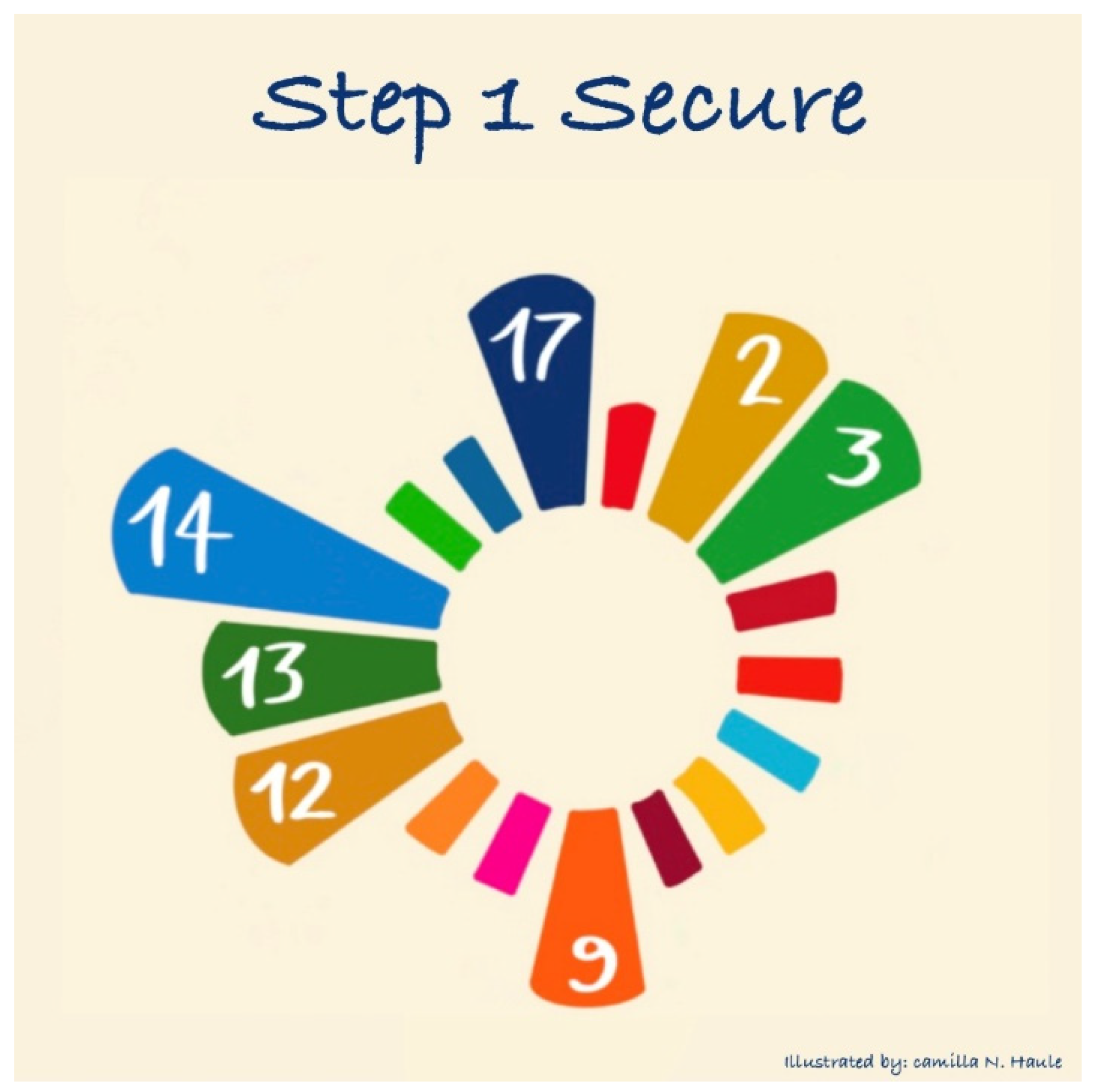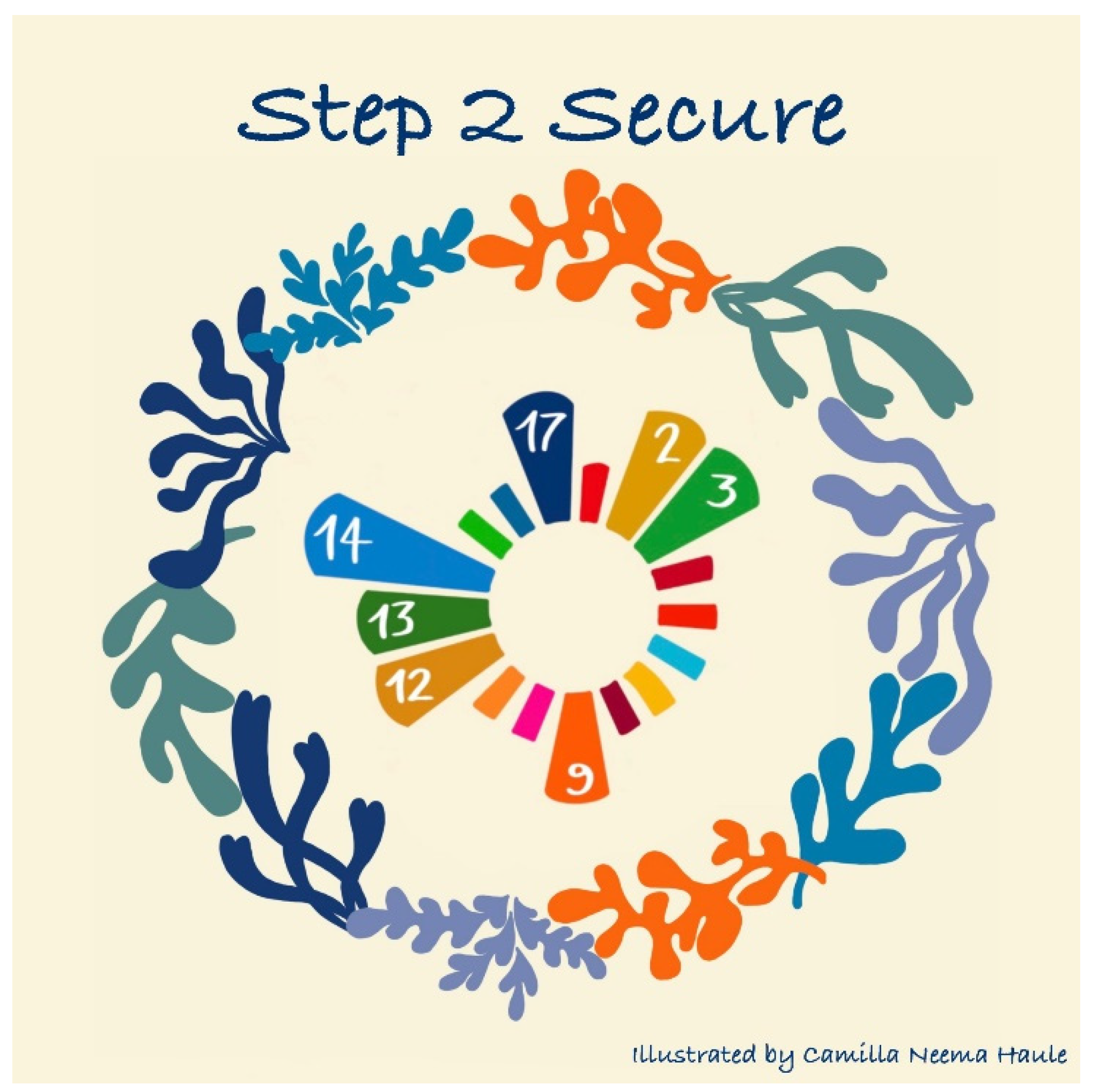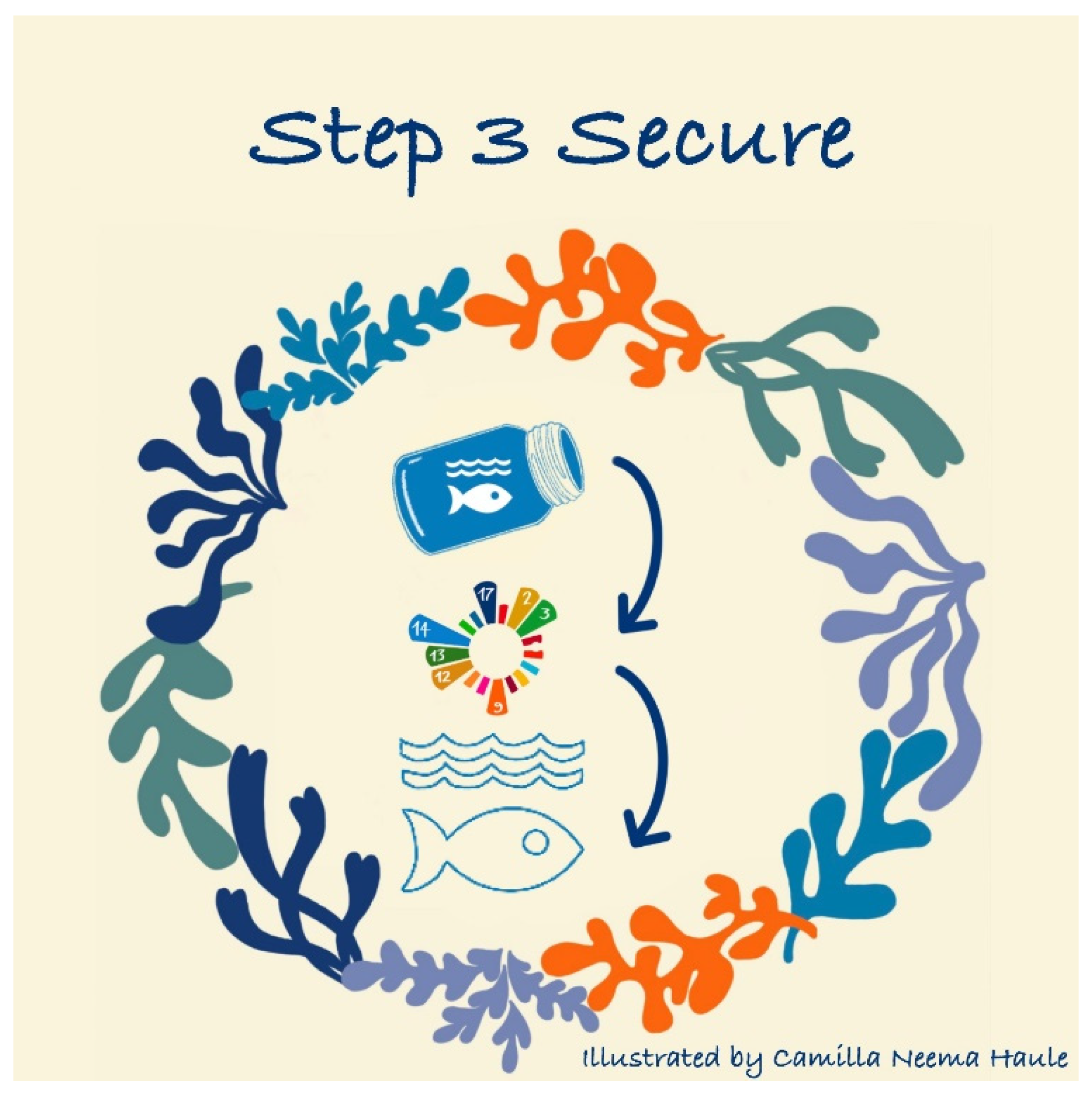Suggestions for a Systematic Regulatory Approach to Ocean Plastics
Abstract
:1. Introduction
2. Materials and Methods
2.1. Problem-Solving Approach
2.2. Drawing Insights from the Definition of Plastics and Its Impacts on the (Marine) Environment, Food Security, Food Safety, and Human Health
2.2.1. Definition
2.2.2. Impacts
2.3. Understanding the State-Of-The-Art of Plastics Regulation
2.4. Combining the Two Understandings with the Proposal of an Integrated Framework
3. Results
- Contain a definition of plastics developed from the most advanced research in the field;
- Be grounded on the precautionary principle and the legitimacy of preventive actions, according to the international and European legal provisions [13];
- Be based on the premise that plastics pollution violates both human and nature rights;
- Provide the most detailed range of measures, with a clear indication of rights and duties (rights of lands, coasts, rivers, and marine ecosystem to be protected and duties of the human communities to act as nature’s guardians);
- Contain a wide range of bans, restrictions, and limits (e.g., broadening the current EU restrictions on certain single-use plastics to all single-use, and expanding such bans outside the EU), sanctions in case of infringement in coordination with the national criminal, civil, and administrative law systems;
- Promote, coordinate with, and implement systems that emphasize circular waste management practices and the use of alternative (renewable) resources as supplements or replacements for plastics; be coordinated with an effective reparatory justice system, allowing judicial and administrative reviews through actions initiated by the plurality of actors involved in the plastic justice movement; and
4. Discussion
4.1. Towards the Adoption of a Cross-Disciplinary Systems Thinking Approach
4.2. From Legislation to Implementation: A Comparative Overview of the First Implementing Efforts of Directive EU 2019/904
5. Conclusions
Author Contributions
Funding
Institutional Review Board Statement
Informed Consent Statement
Data Availability Statement
Acknowledgments
Conflicts of Interest
References
- Haram, L.E.; Carlton, J.T.; Ruiz, G.M.; Maximenko, N.A. A Plasticene Lexicon. Mar. Pollut. Bull. 2020, 150, 110714. [Google Scholar] [CrossRef]
- Nurra, N.; Battuello, M.; Mussat Sartor, R.; Favaro, L. Plasticene: Tra Plancton Blu e Micromeduse le Tracce di Una Nuova Epoca, Frida Forum Della Ricerca di Ateneo, Unito. 2020. Available online: https://frida.unito.it/wn_pages/contenuti.php/748_ecosistemi-biodiversit-e-comportamento-animale/540_plasticene-tra-plancton-blu-e-micro-meduse-le-tracce-di-una-nuova-epoca/ (accessed on 15 May 2021).
- Bucci, K.; Tulio, M.; Rochman, C.M. What is known and unknown about the effects of plastic pollution: A meta-analysis and systematic review. Ecol. Appl. 2020, 30, e02044. [Google Scholar] [CrossRef]
- Thomas, P.J.; Perono, G.; Tommasi, F.; Pagano, G.; Oral, R.; Burić, P.; Lyons, D.M. Resolving the effects of environmental micro-and nanoplastics exposure in biota: A knowledge gap analysis. Sci. Total Environ. 2021, 1. [Google Scholar]
- IUCN brief. Available online: https://www.iucn.org/resources/issues-briefs/marine-plastics (accessed on 29 August 2021).
- Sorensen, R.M.; Jovanović, B. From nanoplastic to microplastic: A bibliometric analysis on the presence of plastic particles in the environment. Mar. Pollut. Bull. 2021, 163, 111926. [Google Scholar] [CrossRef]
- Haward, M. Plastic pollution of the world’s seas and oceans as a contemporary challenge in ocean governance. Nat. Commun. 2018, 9, 1–3. [Google Scholar] [CrossRef] [Green Version]
- Ostle, C.; Thompson, R.C.; Broughton, D.; Gregory, L.; Wootton, M.; Johns, D.G. The rise in ocean plastics evidenced from a 60-year time series. Nat. Commun. 2019, 10, 1622. [Google Scholar] [CrossRef]
- Mitrano, D.M.; Wohlleben, W. Microplastic regulation should be more precise to incentivize both innovation and environmental safety. Nat. Commun. 2020, 11, 5324. [Google Scholar] [CrossRef]
- Hartmann, N.B.; Hüffer, T.; Thompson, R.C.; Hassellöv, M.; Verschoor, A.; Daugaard, A.E.; Rist, S.; Karlsson, T.; Brennholt, N.; Cole, M.; et al. Are We Speaking the Same Language? Recommendations for a Definition and Categorization Framework for Plastic Debris. Environ. Sci. Technol. 2019, 53, 1039–1047. [Google Scholar] [CrossRef] [Green Version]
- Da Costa, J.P.; Mouneyrac, C.; Costa, M.; Duarte, A.C.; Rocha-Santos, T. The Role of Legislation, Regulatory Initiatives and Guidelines on the Control of Plastic Pollution. Front. Environ. Sci. 2020, 8. [Google Scholar] [CrossRef]
- UNGA. Available online: https://www.un.org/en/development/desa/population/migration/generalassembly/docs/globalcompact/A_CONF.151_26_Vol.I_Declaration.pdf (accessed on 14 June 2021).
- Consolidated Versions of the Treaty on European Union and the Treaty on the Functioning of the European Union (TFEU). Off. J. 2016; C202/1.
- Toussaint, B.; Raffael, B.; Angers-Loustau, A.; Gilliland, D.; Kestens, V.; Petrillo, M.; Rio-Echevarria, I.M.; van den Eede, G. Review of micro- and nanoplastic contamination in the food chain. Food Addit. Contam. 2019, 36, 639–673. [Google Scholar] [CrossRef]
- Di Gregorio, M.; Fatorelli, L.; Paavola, J.; Locatelli, B.; Pramova, E.; Nurrochmat, D.R.; May, P.H.; Brockhaus, M.; Sari, I.M.; Kusumadewi, S.D. Multi-level governance and power in climate change policy networks. Glob. Environ. Change 2019, 94, 64–77. [Google Scholar] [CrossRef]
- Jordan, A. The Politics of Multilevel Environmental Governance: Subsidiarity and Environmental Policy in the European Union. Environ. Plan. A Econ. Space 2000, 32, 1307–1324. [Google Scholar]
- Purdy, J. The long environmental justice movement. Ecol. LQ 2017, 44, 809. [Google Scholar]
- UNEP Press Release: Plastic Pollution Is an Environmental Injustice to Vulnerable Communities—New Report. March 2021. Available online: https://www.unep.org/news-and-stories/press-release/plastic-pollution-environmental-injustice-vulnerable-communities-new (accessed on 14 June 2021).
- Poto, M.P. Salvare la Nostra Casa Comune È l’Affaire Du Siècle. Resp. Civ. Prev. 2021, 3, 1–24. [Google Scholar]
- Transforming Our World: The 2030 Agenda for Sustainable Development. Available online: https://sdgs.un.org/2030agenda (accessed on 6 June 2021).
- SECURE Novel Marine Resources for Food Security and Food Safety. Available online: https://uit.no/research/seafood/project?pid=667623 (accessed on 6 June 2021).
- EFSA. Presence of microplastics and nanoplastics in food, with particular focus on seafood. EFSA J. 2016, 14. [Google Scholar] [CrossRef] [Green Version]
- UNEP Guide on Tackling Plastic Pollution: Tackling Plastic Pollution: Legislative Guide for the Regulation of Single-Use Plastic Products. 2020. Available online: https://wedocs.unep.org/bitstream/handle/20.500.11822/34570/PlastPoll.pdf.pdf?sequence=3&isAllowed=y (accessed on 20 June 2021).
- Salwa, H.N.; Sapuan, S.M.; Mastura, M.T.; Zuhri, M.Y.M. Green bio composites for food packaging. Int. J. Recent Technol. Eng. 2019, 8, 450–459. [Google Scholar] [CrossRef]
- Mendes, A.C.; Pedersen, G.A. Perspectives on sustainable food packaging: Is bio-based plastics the solution? Trends Food Sci. Technol. 2021, 112, 839–846. [Google Scholar] [CrossRef]
- Yong, C.Q.Y.; Valiyaveetill, S.; Tang, B.L. Toxicity of microplastics and nanoplastics in mammalian systems. Int. J. Environ. Res. Public Health 2020, 17, 1509. [Google Scholar] [CrossRef] [PubMed] [Green Version]
- Piccardo, M.; Renzi, M.; Terlizzi, A. Nanoplastics in the oceans: Theory, experimental evidence and real world. Mar. Pollut. Bull. 2020, 157, 111317. [Google Scholar] [CrossRef]
- Cox, K.D.; Covernton, G.A.; Davies, H.L.; Dower, J.F.; Juanes, F.; Dudas, S.E. Human consumption of microplastics. Environ. Sci. Technol. 2019, 53, 7068–7074. [Google Scholar] [CrossRef] [Green Version]
- Wright, S.L.; Kelly, F.J. Plastic and human health: A micro issue? Environ. Sci. Technol. 2017, 51, 6634–6647. Available online: https://pubs.acs.org/doi/pdf/10.1021/acs.est.7b00423 (accessed on 26 June 2021). [CrossRef] [PubMed]
- Lusher, A.; Hollman, P.; Mendoza-Hill, J. Microplastics in Fisheries and Aquaculture: Status of Knowledge on Their Occurrence and Implications for Aquatic Organisms and Food Safety; FAO: Rome, Italy, 2007. [Google Scholar]
- SAPEA. A Scientific Perspective on Microplastics in Nature and Society. 2019. Available online: https://www.sapea.info/wp-content/uploads/report.pdf (accessed on 26 June 2021).
- Microplastics, V.K.M. Occurrence, Levels and Implications for Environment and Human Health Related to Food (2535–4019). 2019. Available online: https://vkm.no/download/18.345f76de16df2bc85a513b4e/1571823698421/20191023%20Microplastics;%20occurrence,%20levels%20and%20implications%20for%20environment%20and%20human%20health%20related%20to%20food.pdf (accessed on 26 June 2021).
- Koelmans, A.; Besseling, E.; Shim, W. Nanoplastics in the aquatic environment. Critical review. In Marine Anthropogenic Litter; Bergmann, M., Gutow, L., Klages, M., Eds.; Springer Open: Cham, Switzerland, 2015; pp. 325–340. [Google Scholar] [CrossRef] [Green Version]
- Danopoulos, E.; Jenner, L.C.; Twiddy, M.; Rotchell, J.M. Microplastic Contamination of Seafood Intended for Human Consumption: A Systematic Review and Meta-Analysis. Environ. Health Perspect. 2020, 128, 126002. [Google Scholar] [CrossRef]
- Gamarro, E.G.; Ryder, J.; Elvevoll, E.O.; Olsen, R.L. Microplastics in Fish and Shellfish—A Threat to Seafood Safety? J. Aquat. Food Prod. Technol. 2020, 29, 417–425. [Google Scholar] [CrossRef]
- Gallo, F.; Fossi, C.; Weber, R.; Santillo, D.; Sousa, J.; Ingram, I.; Nadal, A.; Romano, D. Marine litter plastics and microplastics and their toxic chemicals components: The need for urgent preventive measures. Environ. Sci. Eur. 2018, 30, 1–14. [Google Scholar] [CrossRef]
- IMO. Available online: https://wwwcdn.imo.org/localresources/en/MediaCentre/HotTopics/Documents/IMO%20marine%20litter%20action%20plan%20MEPC%2073-19-Add-1.pdf (accessed on 11 June 2021).
- The Commission to The European Parliament, The Council, The European Economic and Social Committee and the Committee of the Regions a European Strategy for Plastics in a Circular Economy, COM/2018/028 Final. Available online: https://eur-lex.europa.eu/legal-content/EN/TXT/?qid=1516265440535&uri=COM:2018:28:FIN (accessed on 31 May 2021).
- Directive (EU) 2019/904 of the European Parliament and of the Council of 5 June 2019 on the Reduction of the Impact of Certain Plastic Products on the Environment (Text with EEA Relevance). Off. J. Eur. Union 2019, 1–19.
- EU Monitor. Available online: https://www.eumonitor.eu/9353000/1/j9vvik7m1c3gyxp/vh75mdhkg4s0 (accessed on 11 June 2021).
- Poto, M.P. A Conceptual Framework for Complex Systems at the Crossroads of Food, Environment, Health, and Innovation. Sustainability 2020, 12, 9692. [Google Scholar] [CrossRef]
- Poto, M.P.; Morel, M.D. Suggesting an Extensive Interpretation of the Concept of Novelty That Looks at the Bio-Cultural Dimension of Food. Sustainability 2021, 13, 5065. [Google Scholar] [CrossRef]
- Esbjörn-Hargens, S. Integral ecology: The what, who, and how of environmental phenomena. World Futures 2005, 61, 5–49. [Google Scholar] [CrossRef]
- Borràs, S. New transitions from human rights to the environment to the rights of nature. TEL 2016, 5, 113. [Google Scholar] [CrossRef]
- Bender, M. The Earth Law Framework for Marine Protected Areas: Adopting a Holistic, Systems, and Rights-Based Approach to Ocean Governance. Earth Law Cent. 2019. Available online: https://static1.squarespace.com/static/55914fd1e4b01fb0b851a814/t/5adca14b352f538288f4ea67/1524408668126/Final+Draft+3.pdf (accessed on 15 May 2021).
- Battistoni, C.; Giraldo Nohra, C.; Barbero, S. A systemic design method to approach future complex scenarios and research towards sustainability: A holistic diagnosis tool. Sustainability 2019, 11, 4458. [Google Scholar] [CrossRef] [Green Version]
- De Sousa, F.D.B. The role of plastic concerning the sustainable development goals: The literature point of view. Clean. Responsible Consum. 2021, 1. [Google Scholar]
- Walker, T.R. (Micro) plastics and the UN sustainable development goals. Curr. Opin. Green Sustain. Chem. 2021, 1. [Google Scholar]
- Ramos, G.; Hynes, W.; Müller, J.M.; Lees, M. Systemic Thinking for Policy Making: The Potential of Systems Analysis for Addressing Global Policy Challenges in the 21st Century; OECD Publishing: Paris, France, 2019; Available online: https://www.oecd.org/naec/averting-systemic-collapse/SG-NAEC(2019)4_IIASA-OECD_Systems_Thinking_Report.pdf (accessed on 8 September 2021).
- Eden, J.; Levit, L.; Berg, A.; Morton, S. Standards for Initiating a Systematic Review. Finding What Works in Health Care: Standards for Systematic Reviews; The National Academies Press: Washington, DC, USA, 2011. [Google Scholar]
- Pierson-Brown, T. (Systems) Thinking Like A Lawyer. Clin. L. Rev. 2019, 26, 515. [Google Scholar]
- Flood, R.L. The relationship of ‘systems thinking’ to action research. Syst. Pract. Action Res. 2010, 23, 269–284. [Google Scholar] [CrossRef]
- Loi n° 2020-105 du 10 Février 2020 Relative à la Lutte Contre le Gaspillage et à L’économie circulaire, NOR: TREP1902395L, Available at JORF n°0035 du 11 Février. 2020. Available online: https://www.legifrance.gouv.fr/loda/id/JORFTEXT000041553759/ (accessed on 12 September 2021).
- Verordnung über das Verbot des Inverkehrbringens von Bestimmten Einwegkunststoffprodukten und von Produkten aus Oxo-abbaubarem Kunststoff* (Einwegkunststoffverbotsverordnung-EWKVerbotsV) EWKVerbotsV Ausfertigungsdatum: 20.01.2021. Available online: https://www.gesetze-im-internet.de/ewkverbotsv/EWKVerbotsV.pdf (accessed on 12 September 2021).




Publisher’s Note: MDPI stays neutral with regard to jurisdictional claims in published maps and institutional affiliations. |
© 2021 by the authors. Licensee MDPI, Basel, Switzerland. This article is an open access article distributed under the terms and conditions of the Creative Commons Attribution (CC BY) license (https://creativecommons.org/licenses/by/4.0/).
Share and Cite
Poto, M.P.; Elvevoll, E.O.; Sundset, M.A.; Eilertsen, K.-E.; Morel, M.; Jensen, I.-J. Suggestions for a Systematic Regulatory Approach to Ocean Plastics. Foods 2021, 10, 2197. https://doi.org/10.3390/foods10092197
Poto MP, Elvevoll EO, Sundset MA, Eilertsen K-E, Morel M, Jensen I-J. Suggestions for a Systematic Regulatory Approach to Ocean Plastics. Foods. 2021; 10(9):2197. https://doi.org/10.3390/foods10092197
Chicago/Turabian StylePoto, Margherita Paola, Edel Oddny Elvevoll, Monica Alterskjær Sundset, Karl-Erik Eilertsen, Mathilde Morel, and Ida-Johanne Jensen. 2021. "Suggestions for a Systematic Regulatory Approach to Ocean Plastics" Foods 10, no. 9: 2197. https://doi.org/10.3390/foods10092197
APA StylePoto, M. P., Elvevoll, E. O., Sundset, M. A., Eilertsen, K.-E., Morel, M., & Jensen, I.-J. (2021). Suggestions for a Systematic Regulatory Approach to Ocean Plastics. Foods, 10(9), 2197. https://doi.org/10.3390/foods10092197








